Increased solar activity – Second major solar flare of day, X2.1 from Region 1882
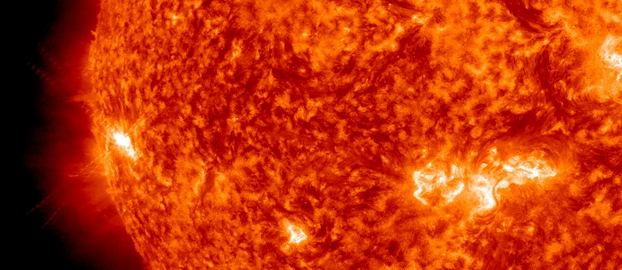
AR 1882 erupted with major solar flare measuring X2.1 at 15:03 UTC on October 25, 2013.
Type II and IV radio emissions were associated with the event. Type IV emissions occur in association with major eruptions on the Sun and are typically associated with strong coronal mass ejections and solar radiation storms. A 10 cm Radio Burst was also associated with the event.
Earlier on October 25th, AR 1882 erupted with strong X1.7 and moderate M1.0 flare. Check the report on that here or scroll down for timeline of latest events.
With those already present, there are more interesting active regions coming into Earth view and this period of increased solar activity will continue.
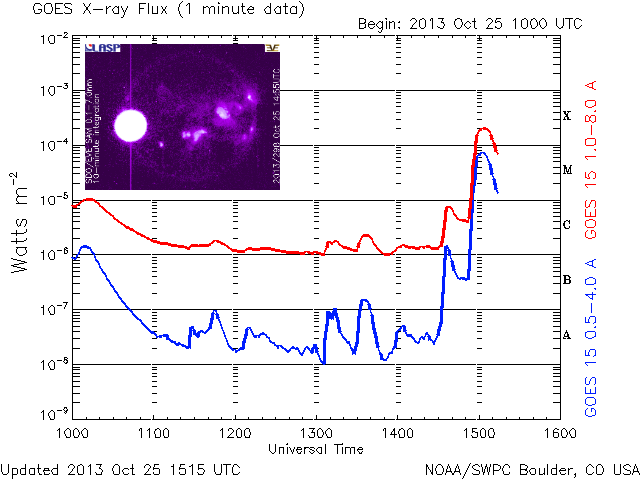
ALERT: Type II Radio Emission
Begin Time: 2013 Oct 25 1458 UTC
Estimated Velocity: 2078 km/s
Comment: Sagamore Hill reported a speed of 2078 km/s; San Vito reported a speed of 2105 km/s
Description: Type II emissions occur in association with eruptions on the sun and typically indicate a coronal mass ejection is associated with a flare event.
***
ALERT: Type IV Radio Emission
Begin Time: 2013 Oct 25 1458 UTC
Description: Type IV emissions occur in association with major eruptions on the sun and are typically associated with strong coronal mass ejections and solar radiation storms.
***
SUMMARY: X-ray Event exceeded X1
Begin Time: 2013 Oct 25 1451 UTC
Maximum Time: 2013 Oct 25 1503 UTC
End Time: 2013 Oct 25 1512 UTC
X-ray Class: X2.1
Location: S06E69
NOAA Scale: R3 – Strong
Potential Impacts: Area of impact consists of large portions of the sunlit side of Earth, strongest at the sub-solar point.
Radio – Wide area blackout of HF (high frequency) radio communication for about an hour.
***
SUMMARY: 10 cm Radio Burst
Begin Time: 2013 Oct 25 1457 UTC
Maximum Time: 2013 Oct 25 1514 UTC
End Time: 2013 Oct 25 1541 UTC
Duration: 44 minutes
Peak Flux: 370 sfu
Latest Penticton Noon Flux: 161 sfu
Description: A 10cm radio burst indicates that the electromagnetic burst associated with a solar flare at the 10cm wavelength was double or greater than the initial 10cm radio background. This can be indicative of significant radio noise in association with a solar flare. This noise is generally short-lived but can cause interference for sensitive receivers including radar, GPS, and satellite communications.
Global eruptions on the Sun
Spaceweather reports that X1.7-flare was bracketed by two erupting magnetic filaments, each located hundreds of thousands of kilometers from AR1882. In other words, the X1.7 flare might have been just one piece of an interconnected global eruption.
Last time scientists observed something like this was on August 1, 2010, when an entire hemisphere of the Sun erupted. Filaments of magnetism snapped and exploded, shock waves raced across the stellar surface, billion-ton clouds of hot gas billowed into space. Astronomers knew they had witnessed something big. It was so big, it may have shattered old ideas about solar activity. Read more about it here.
On October 26th it happened again. Click here and watch Sun's southwestern quadrant – a sequence of flare activity around sunspots AR 1875 and AR 1877 followed by a filament eruption off the SW limb.
Increased solar activity
This period of increased solar activity will continue in the coming days. NOAA SWPC forecasters estimated 65% chance for M-class flare, and 35% chance for X-class flare for October 27 – 29.
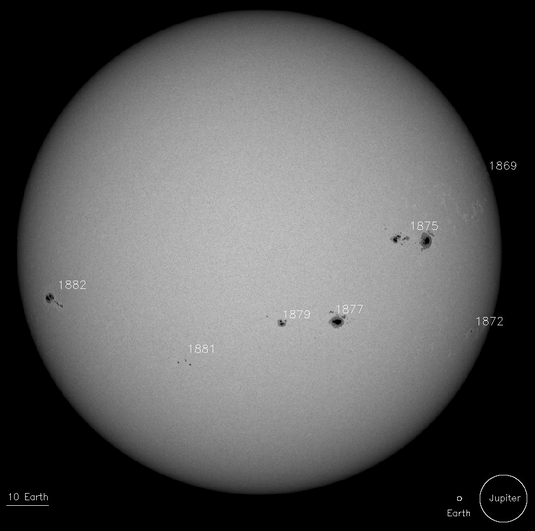
Active regions – Earth side of the disk – October 26, 2013. Image credit: NASA SDO/HMI
1869 – Alpha
1872 – Beta
1875 – Beta-Gamma-Delta
1877 – Beta-Gamma
1879 – Beta
1881 – Beta
1882 – Beta-Gamma-Delta
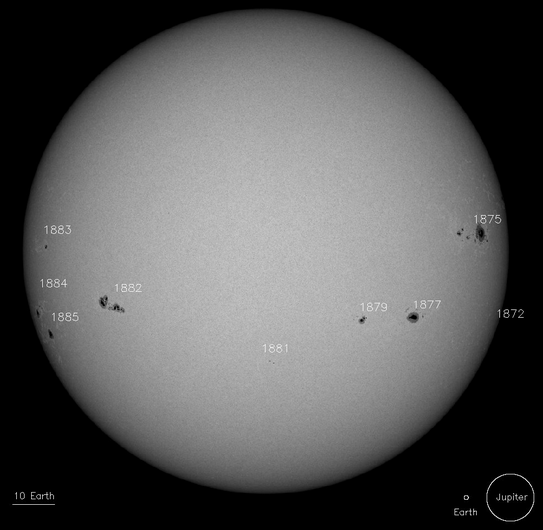
Active regions – Earth side of the disk – October 27, 2013. Image credit: NASA SDO/HMI
1869 – Alpha
1872 – Beta
1875 – Beta-Gamma-Delta
1877 – Beta-Gamma
1879 – Beta
1881 – Beta
1882 – Beta-Gamma-Delta
1883 – Alpha
1884 – Alpha
1885 – Alpha
Timeline of M and X class eruptions: October 23 – 29, 2013
- October 23, 2013 – 20:53 UTC – M2.7 from Region 1875
- October 23, 2013 – 23:43 UTC – M1.4 from Region 1875
- October 24, 2013 – 00:08 UTC – M3.1 from Region 1875
- October 24, 2013 – 00:30 UTC – M9.3 from Region 1877
- October 24, 2013 – 10:09 UTC – M2.5 from Region 1875
- October 24, 2013 – 10:33 UTC – M3.5 from Region 1875
- October 25, 2013 – 03:02 UTC – M2.9 from Region 1882
- October 25, 2013 – 08:01 UTC – X1.7 from Region 1882 – Global eruption on the Sun
- October 25, 2013 – 10:11 UTC – M1.0 from Region 1882
- October 25, 2013 – 15:03 UTC – X2.1 from Region 1882 – Very bright CME produced. Glancing blow expected on October 28.
- October 25, 2013 -17:09 UTC – M1.3 from Region 1882
- October 25, 2013 -19:21 UTC – M2.3 from Region 1882
- October 25, 2013 – 20:58 UTC – M1.9 from Region 1882
- October 26, 2013 – 06:06 UTC – M2.3 from Region 1882
- October 26, 2013 – 09:37 UTC – M1.5 from Region 1882
- October 26, 2013 – 11:17 UTC – M1.8 from Region 1882
- October 26, 2013 – 19:27 UTC – M3.1 from Region 1884
- October 26, 2013 – 19:53 UTC – M1.0 from Region 1882
- October 27, 2013 – 12:48 UTC – M3.5 from Region 1875
- October 28, 2013 – 02:03 UTC – X1.0 from Region 1875 – Bright CME. Glancing blow expected on October 31.
- October 28, 2013 – 04:41 UTC – M5.1 from Region 1875
- October 28, 2013 – 11:52 UTC – M1.4 from Region 1877
- October 28, 2013 – 14:05 UTC – M2.8 from Region 1875
- October 28, 2013 – 15:01 UTC – M2.7 from Region 1882
- October 28, 2013 – 15:15 UTC – M4.4 from Region 1882
- October 28, 2013 – 20:57 UTC – M1.5 from Region 1875
- October 29, 2013 – 21:54 UTC – X2.3 from Region 1875
CME's from X-class flares are expected to deliver a glancing blow to Earth's magnetic field on October 28, 2013. NOAA SWPC forecasters estimate a 20% chance of polar geomagnetic storms.
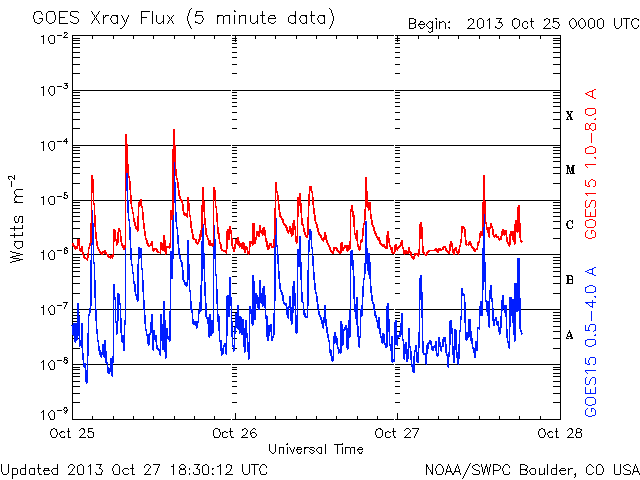
Follow Sun's activity in almost real-time on SWS.
Featured image: NASA SDO AIA 304

Commenting rules and guidelines
We value the thoughts and opinions of our readers and welcome healthy discussions on our website. In order to maintain a respectful and positive community, we ask that all commenters follow these rules:
We reserve the right to remove any comments that violate these rules. By commenting on our website, you agree to abide by these guidelines. Thank you for helping to create a positive and welcoming environment for all.